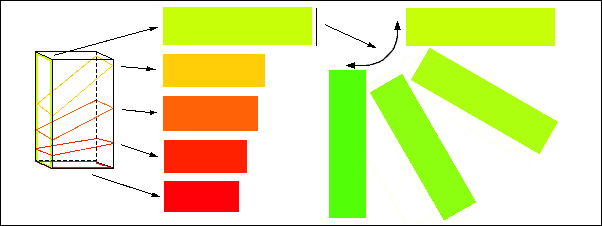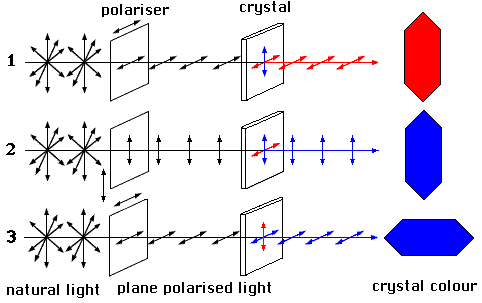
Pleochroism as a diagnostic character
Pleochroism is the ability of a mineral to absorb different wavelengths of transmitted light depending upon its crystallographic orientations.
This is the property which some minerals present by which they appear to be a different colour depending on the direction in which they are observed, i.e. according to the direction of vibration of the waves that cross them.

Just as the refractive index changes with direction, the selective absorption of light by some anisotropic minerals also does so, and as this is responsible for colour, this changes with direction.
In the diagram, we can see how when two plates are cut from the same mineral but in a different direction (A and B), the colour is different. When the incident white light (1), composed of the six principle colours (2), reaches the crystal, the orange (A) or green (B) component is absorbed (3), allowing the rest (4) to pass through, but as the complementary pairs of colours give white light (5), we see only the colour whose pair is absent (6).

The above happens when natural light is used, but if we use polarised light, we are introducing an additional factor, as apart from the cut of the crystal, the direction of vibration of the light will also intervene.
This screen shows what occurs when working with polarised light.
In case (1), the light arrives vibrating horizontally and the mineral is seen as red, because for this direction (the red one in the diagram) only the radiations corresponding to green are absorbed. Without changing the cut of the mineral nor its position (i.e without rotating it), in case (2), but turning the direction of vibration of the polariser round by 90º (in the diagram it is now in a vertical position), the crystal is seen as blue (the radiations corresponding to orange have been absorbed).
Normally, the polariser remains fixed in the microscope and it is the mineral which is turned (by rotating the stage), case 3. The result is the same as if the polariser had been turned (case 2).

A pleochroic mineral literally changes color as it is rotated on the microscope stage while viewed using plane-polarized light.
In order to see whether a mineral is pleochroic or not, you only have to turn the microscope stage and observe whether the crystals of a particular mineral experience changes in their colouring.
Pleochroism may manifest itself by:
![]() a change in actual colour (e.g. in some positions
the mineral is seen as blue and in others as red) or
a change in actual colour (e.g. in some positions
the mineral is seen as blue and in others as red) or
![]() by a change in the intensity of colour (from
light blue to dark blue).
by a change in the intensity of colour (from
light blue to dark blue).
Pleochroism as a diagnostic character
Pleochroism is a very important property for mineral recognition since non-pleochroic minerals are much more abundant than those that are.
Pleochroism is very varied.
| Yellow |
|
|||
| yellow - yellow | yellow - brown | orange - orange | yellow - red | |
| Brown |
|
|
||
| brown - colorless | brown - colorless | brown - green - colorless | brorn - yellow | |
| Brown |
|
|
|
|
| light brown - dark brown | light brown - dark brown | light brown - dark brown | light brown - very dark brown | |
| Brown |
|
|
|
|
| light brown - very dark brown | light brown - very dark brown | light brown - very dark brown | dark brown - very dark brown | |
| Red | ||||
| brown - reddish brown | red - orange - yellow | light red - dark red | ||
| Green |
|
|
|
|
| very light green - very light green | very light green - green | very light green - green - bluish | light green - green | |
| Green |
|
|
|
|
| light green - dark green | very light green - dark green | green - dark blue | yellow - green - dark brown | |
| Blue |
|
|
|
|
| light indigo blue - colorless | light purple blue - colorless | light indigo blue - colorless | very light blue - very dark blue | |
| Blue |
|
|||
| very dark blue green |